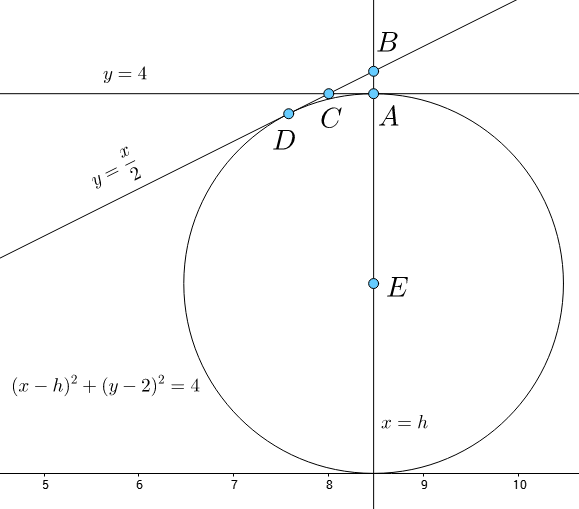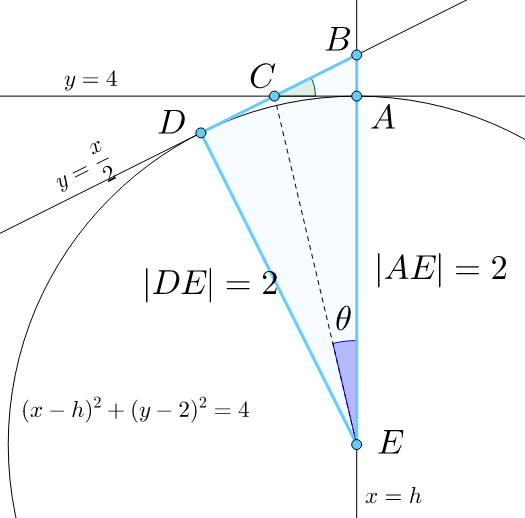Circle problem
What is the x -coordinate of the center of the circle in the first quadrant tangent to the lines y = 2 x , y = 4 and the x -axis?
Take O as the origin.
This section requires Javascript.
You are seeing this because something didn't load right. We suggest you, (a) try
refreshing the page, (b) enabling javascript if it is disabled on your browser and,
finally, (c)
loading the
non-javascript version of this page
. We're sorry about the hassle.
2 solutions
That was good, Thanks for the solution :)
Observe that y = 4 and the x − a x i s act as two parallel tangents to our circle, therefore they lie on opposite ends of a diameter of our circle. Thus, we obtain the length of diameter as 4 units. Since the diameter is also perpendicular to the x − a x i s , therefore the ordinate of the center of the circle will be equal to the radius of the circle which is 2 .
Let the center of this circle be ( h , 2 ) .
Since its radius is 2 units, therefore its perpendicular distance from the third tangent, ( y = 2 x ≡ x − 2 y = 0 ) will also be 2 units.
The distance of ( h , 2 ) from the line x − 2 y = 0 , is given by
D = ∣ ∣ ∣ ∣ 5 h − 4 ∣ ∣ ∣ ∣ = 2
Solving for h ,
⟹ ⟹ ⟹ ⟹ ⟹ ∣ ∣ ∣ ∣ 5 h − 4 ∣ ∣ ∣ ∣ = 2 5 ( h − 4 ) 2 = 4 h 2 − 8 h − 4 = 0 h = 2 8 ± 8 0 h = 4 ± 2 5 h = 4 + 2 5 As ′ h ′ should be positive but 4 − 2 5 < 0
Nice one bro!
Recall that the form of the circle in the Cartesian plane is ( x − h ) 2 + ( y − k ) 2 = r 2 where
Given that the circle is bounded by x -axis and the graph of y = 4 , the center is ( h , 2 ) , and the radius is r = 2 , which give ( x − h ) 2 + ( y − 2 ) 2 = 4 Here is the diagram of the graphs: Figure 1. Graphs of lines and circle.
where
A
=
(
h
,
4
)
,
B
=
(
h
,
2
h
)
,
C
=
(
8
,
4
)
and
D
are intersection points of the graphs. Take a careful look where I included the dashed line and shaded
Δ
B
E
D
:
Figure 1. Graphs of lines and circle.
where
A
=
(
h
,
4
)
,
B
=
(
h
,
2
h
)
,
C
=
(
8
,
4
)
and
D
are intersection points of the graphs. Take a careful look where I included the dashed line and shaded
Δ
B
E
D
:
 Figure 2. Triangular region shaded by baby blue color. From
∠
A
C
B
, we work our way to determine
θ
=
∠
A
E
C
.
The goal of this problem is to determine the measurement of
θ
=
∠
A
E
C
, indicated by the dark-blue color on the arc. Then, find
h
by trigonometry.
Figure 2. Triangular region shaded by baby blue color. From
∠
A
C
B
, we work our way to determine
θ
=
∠
A
E
C
.
The goal of this problem is to determine the measurement of
θ
=
∠
A
E
C
, indicated by the dark-blue color on the arc. Then, find
h
by trigonometry.
Since the graph of y = 4 is parallel to x -axis, the intersection of y = 2 x and y = 4 forms ∠ A C B = arctan ( 2 1 ) and ∠ A C D = 1 8 0 ∘ − ∠ A C B = 1 8 0 ∘ − arctan ( 2 1 ) . Then, since ∣ D E ∣ = ∣ A E ∣ = 2 and both D E ⊥ D C and A E ⊥ A C , which implies ∠ C D E = ∠ C A E = 9 0 ∘ , this shows that ∠ A E D = arctan ( 2 1 ) . Thereby, θ = ∠ A E C = 2 1 arctan ( 2 1 ) .
So elementary trigonometry (see Note for evaluating arctan ) shows that tan ( θ ) ∣ A C ∣ = ∣ A E ∣ ∣ A C ∣ = ∣ A E ∣ tan ( θ ) = 2 tan ( 2 1 arctan ( 2 1 ) ) = 2 ( 5 − 2 ) = 2 5 − 4 Thus, h − 8 h = 2 5 − 4 = 4 + 2 5
Note
To prove that tan ( 2 1 arctan ( 2 1 ) ) = 5 − 2 , apply half-angle identity: tan ( 2 1 γ ) = sin ( γ ) 1 − cos ( γ ) Letting γ = arctan ( 2 1 ) , we have cos ( arctan ( 2 1 ) ) sin ( arctan ( 2 1 ) ) = cos ( arccos ( 5 2 ) ) = 5 2 = sin ( arcsin ( 5 1 ) ) = 5 1 So tan ( 2 1 γ ) = 5 1 1 − 5 2 ⋅ 5 5 = 5 − 2
These diagrams are done by GeoGebra .